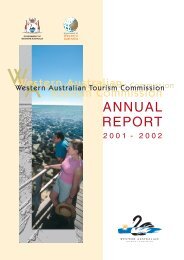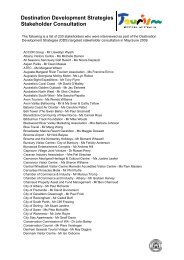An Introduction to Risk Management - Tourism Western Australia
An Introduction to Risk Management - Tourism Western Australia
An Introduction to Risk Management - Tourism Western Australia
Create successful ePaper yourself
Turn your PDF publications into a flip-book with our unique Google optimized e-Paper software.
<strong>An</strong> <strong>Introduction</strong> <strong>to</strong> <strong>Risk</strong> <strong>Management</strong><br />
For Event Holders in <strong>Western</strong> <strong>Australia</strong><br />
May 2013
<strong>An</strong> introduction <strong>to</strong> <strong>Risk</strong> <strong>Management</strong> for Event Holders<br />
All printed copies are uncontrolled<br />
<strong>Tourism</strong> <strong>Western</strong> <strong>Australia</strong><br />
May 2013<br />
Page | 2
<strong>An</strong> introduction <strong>to</strong> <strong>Risk</strong> <strong>Management</strong> for Event Holders<br />
Contents<br />
Disclaimer ............................................................................................................................. 4<br />
<strong>Introduction</strong> ........................................................................................................................... 5<br />
Definitions ............................................................................................................................. 6<br />
Why do we need <strong>to</strong> manage risk ........................................................................................... 7<br />
When do we need <strong>to</strong> manage risk ......................................................................................... 7<br />
<strong>Risk</strong> management is a five step process ............................................................................... 7<br />
<strong>Risk</strong> <strong>Management</strong> Process ................................................................................................... 8<br />
Communication & Consultation ............................................................................................. 9<br />
STEP 1 Establish the Context........................................................................................... 9<br />
STEP 2 Identify <strong>Risk</strong>s ..................................................................................................... 11<br />
STEP 3 <strong>An</strong>alyse and Evaluate <strong>Risk</strong>s .............................................................................. 12<br />
STEP 4 Treat <strong>Risk</strong>s ........................................................................................................ 13<br />
STEP 5 Moni<strong>to</strong>r & Review .............................................................................................. 13<br />
Additional Resources .......................................................................................................... 14<br />
Attachment A – Sample <strong>Risk</strong> Reference Tables .................................................................. 15<br />
Attachment B – Sample <strong>Risk</strong> Identification Worksheets ...................................................... 18<br />
Page | 3
<strong>An</strong> introduction <strong>to</strong> <strong>Risk</strong> <strong>Management</strong> for Event Holders<br />
Disclaimer<br />
The <strong>Western</strong> <strong>Australia</strong>n <strong>Tourism</strong> Commission ("<strong>Tourism</strong> WA") has prepared and compiled<br />
this publication in good faith and by way of general assistance <strong>to</strong> actual or potential event<br />
holders, and others. This publication is a general guide only and the content must be<br />
independently verified and tested by the reader <strong>to</strong> ascertain whether it suits or is helpful <strong>to</strong> or<br />
in respect of the reader, the reader's particular circumstances and the proposed event.<br />
Neither <strong>Tourism</strong> WA nor the State of <strong>Western</strong> <strong>Australia</strong> ("State") nor any officer, employee or<br />
contrac<strong>to</strong>r of either <strong>Tourism</strong> WA or the State shall be liable, in negligence or howsoever, for<br />
any loss, damage, injury or liability incurred or sustained by anyone reading or relying upon<br />
any aspect of this publication or its content which is or is held <strong>to</strong> be inaccurate, unreliable,<br />
incomplete, misleading, deceptive or otherwise deficient. In the preceding provisions of this<br />
disclaimer, "content" includes expressed or implied, and actual or alleged, facts, information,<br />
advice, statements, projections, representations and opinions.<br />
Page | 4
<strong>An</strong> introduction <strong>to</strong> <strong>Risk</strong> <strong>Management</strong> for Event Holders<br />
<strong>Introduction</strong><br />
<strong>Risk</strong> <strong>Management</strong> is about being aware of what may happen when planning and delivering<br />
an event. It is concerned with taking steps <strong>to</strong> limit the chances of negative impacts occurring<br />
or deciding <strong>to</strong> accept that something may occur and being prepared for the consequences.<br />
It is also concerned with maximising the opportunities associated with an event, and<br />
ensuring it is as successful and safe as possible.<br />
Obviously, risk management is not necessarily something new. Individuals undertake risk<br />
management every day. Putting away the hose after watering the garden <strong>to</strong> avoid tripping<br />
over, or putting on a seatbelt whilst travelling by car are both examples of sensible risk<br />
management.<br />
The emphasis is on event holders <strong>to</strong> undertake a structured approach <strong>to</strong> risk management<br />
so that they can make good decisions and demonstrate <strong>to</strong> others that they have a<br />
transparent process which shows how they reached those decisions. Those decisions will<br />
often relate <strong>to</strong> whether or not certain risks will be accepted. <strong>Risk</strong> management also gives<br />
event holders a systematic approach <strong>to</strong> identify and manage key risk exposures so that they<br />
can direct their resources <strong>to</strong>wards the area where they will be most effective. No<br />
organisation has infinite resources, so being able <strong>to</strong> prioritise can be very useful in<br />
successful event planning and delivery.<br />
This resource aims <strong>to</strong> provide practical guidance <strong>to</strong> event holders <strong>to</strong> assist with managing<br />
risks associated with their events.<br />
The resource was primarily developed <strong>to</strong> support event holders that are successful in<br />
receiving event funding through the Regional Events Scheme. However, the content is<br />
applicable <strong>to</strong> any event holder and aligns with the <strong>Australia</strong>n New Zealand Standard: <strong>Risk</strong><br />
<strong>Management</strong> – Principles and Guidelines (AS/NZS ISO 3100:2009).*<br />
This resource should also be read in conjunction with the publication: Resource for Events in<br />
<strong>Western</strong> <strong>Australia</strong> <strong>to</strong> assist in safe and efficient event planning and conduct Oc<strong>to</strong>ber 2012,<br />
available from <strong>Tourism</strong> WA’s website www.<strong>to</strong>urism.wa.gov.au<br />
*Copies of this Standard are available from Standard <strong>Australia</strong>’s website www.standards.org.au<br />
Page | 5
<strong>An</strong> introduction <strong>to</strong> <strong>Risk</strong> <strong>Management</strong> for Event Holders<br />
Definitions<br />
What is risk management<br />
In this context, it is the practice of systematically identifying, understanding and managing<br />
the risks encountered in the conceptualisation, planning, implementation and operation of<br />
events.<br />
What is risk<br />
The impact uncertainty has on an event. It is measured in terms of likelihood and<br />
consequences (for example, the likelihood that an incident/accident might happen and<br />
prevent an event holder from successfully completing what it is they are setting out <strong>to</strong> do).<br />
What is risk transfer<br />
Shifting responsibility or burden for loss <strong>to</strong> another party through legislation, contract,<br />
insurance or other means.<br />
What are risk reference tables<br />
<strong>Risk</strong> Reference Tables are developed for the purpose of establishing guidance as <strong>to</strong> how<br />
risks are <strong>to</strong> be evaluated, assessed, measured, accepted and moni<strong>to</strong>red. Commonly there<br />
are five tables used:<br />
Table 1 – Existing Controls Rating Table<br />
Table 2 – Consequence Table (Qualitative Measures of Consequence)<br />
Table 3 – Likelihood Table (Qualitative Measures of Likelihood)<br />
Table 4 – <strong>Risk</strong> Assessment Criteria Table<br />
Table 5 – <strong>Risk</strong> Acceptance Criteria Table<br />
For a sample of these types of tables refer <strong>to</strong> Attachment A – Sample <strong>Risk</strong> Reference Tables<br />
What is a risk register<br />
A <strong>to</strong>ol used <strong>to</strong> record information derived from performing a risk management process.<br />
Page | 6
<strong>An</strong> introduction <strong>to</strong> <strong>Risk</strong> <strong>Management</strong> for Event Holders<br />
Why do we need <strong>to</strong> manage risk<br />
It is simply good management practice. It also provides structure and form <strong>to</strong> the decision<br />
making processes.<br />
Some good reasons <strong>to</strong> manage risks include:<br />
<br />
<br />
<br />
<br />
<br />
<br />
<br />
<br />
<br />
<br />
Helps with event planning.<br />
Reducing unexpected and costly surprises.<br />
More effective and efficient allocation of resources.<br />
Better results from event management.<br />
Assists <strong>to</strong> clearly define insurance needs, and obtain insurance cover.<br />
Better information for decision-making.<br />
Compliance with regula<strong>to</strong>ry requirements.<br />
Assists in preparation for auditing.<br />
Lessening risk encourages more people <strong>to</strong> participate in the event.<br />
Balancing opportunity and risk.<br />
When do we need <strong>to</strong> manage risk<br />
<strong>Risk</strong> <strong>Management</strong> is a way of looking at an event and considering what can s<strong>to</strong>p the<br />
organiser from achieving what they want <strong>to</strong> achieve. Therefore, risk management is an<br />
on-going process that can be applied <strong>to</strong> all aspects of an event. Event holders should carry<br />
out a risk assessment for any new event, but it is also a continuous process that is designed<br />
<strong>to</strong> help them prioritise where <strong>to</strong> dedicate resources and funds, which means the assessment<br />
should be revisited every time you hold an event and always have it ‘front of mind’.<br />
<strong>Risk</strong> management is a five step process<br />
STEP 1<br />
STEP 2<br />
STEP 3<br />
STEP 4<br />
STEP 5<br />
Establish the context.<br />
Identify risks.<br />
<strong>An</strong>alyse and evaluate risks.<br />
Treat risks.<br />
Ongoing moni<strong>to</strong>ring and review.<br />
Important<br />
Throughout each step it is essential that there is consultation and communication with<br />
everyone involved in the event including (internal and external stakeholders).<br />
Page | 7
<strong>An</strong> introduction <strong>to</strong> <strong>Risk</strong> <strong>Management</strong> for Event Holders<br />
<strong>Risk</strong> <strong>Management</strong> Process<br />
Page | 8
<strong>An</strong> introduction <strong>to</strong> <strong>Risk</strong> <strong>Management</strong> for Event Holders<br />
Communication & Consultation<br />
Communication and consultation are essential <strong>to</strong> the overall risk management process.<br />
The effectiveness of an event holders’ risk management process depends upon, amongst<br />
other things, involving the right people at the right time and ensuring they understand, are<br />
involved in, and contribute <strong>to</strong> the process.<br />
Each step of the risk management process relies on communication and consultation <strong>to</strong><br />
achieve its purpose. For instance in:<br />
<br />
<br />
<br />
<br />
<br />
Setting the context - consultation with internal and external stakeholders is essential <strong>to</strong><br />
reach a thorough understanding of the operating environment and <strong>to</strong> define the<br />
purpose and scope of the exercise.<br />
<strong>Risk</strong> identification - a diversity of input can prevent important risks being overlooked<br />
and ensure that risks are accurately described.<br />
<strong>Risk</strong> assessment - communication and consultation allows all perspectives <strong>to</strong> be<br />
considered in arriving at a realistic level of risk.<br />
<strong>Risk</strong> treatment - is more effective because treatment plans are better unders<strong>to</strong>od.<br />
Moni<strong>to</strong>r and review - depends upon effective communication <strong>to</strong> ensure risk information<br />
is in use and current.<br />
Communication and consultation does not mean asking everybody their opinion about<br />
everything. When planning consider the following in relation <strong>to</strong> communication and<br />
consultation requirements:<br />
<br />
<br />
<br />
<br />
Objectives – what are the aims of involving different people in the process?<br />
Participants – who are the appropriate parties <strong>to</strong> be involved at each step of the<br />
process?<br />
Perspectives – what particular contribution or view point is anticipated and required<br />
from each participant?<br />
Methods – how will consultation take place? It may not always be practical <strong>to</strong> get all<br />
the parties <strong>to</strong>gether in one place.<br />
STEP 1<br />
Establish the Context<br />
Effectively identify risks will include taking in<strong>to</strong> account the event objectives and event holder<br />
capabilities as well as fac<strong>to</strong>rs external <strong>to</strong> the organisation or event.<br />
1. Overview<br />
Be clear on:<br />
<br />
<br />
The scope and objectives of the risk management planning in relation <strong>to</strong> the<br />
event.<br />
<strong>An</strong>swering the ‘who’, ‘what’, ‘when’, ‘how’ and – ‘with what’ questions?<br />
o Who is going <strong>to</strong> be involved?<br />
Page | 9
<strong>An</strong> introduction <strong>to</strong> <strong>Risk</strong> <strong>Management</strong> for Event Holders<br />
o What are they actually going <strong>to</strong> be doing?<br />
o When are they going <strong>to</strong> be doing it?<br />
o How are they going <strong>to</strong> do it?<br />
o With what resources will they undertake this?<br />
2. Develop <strong>Risk</strong> Criteria<br />
<br />
Develop risk criteria – decide the criteria against which risks are <strong>to</strong> be evaluated.<br />
Important criteria that should be considered include:<br />
o the kinds of consequences that will be considered<br />
o how likelihood will be defined<br />
o how it is determined whether the risk level is such that further treatment<br />
activities are required.<br />
Note: A set of sample risk reference tables (i.e. risk criteria) have been provided at<br />
Attachment A. These tables are examples only and event holders will need <strong>to</strong> develop their<br />
own, relevant <strong>to</strong> the event. Remember, it is not possible <strong>to</strong> understand a risk assessment<br />
without documenting the risk reference tables that have been used.<br />
3. <strong>Risk</strong> Assessment (specific issues)<br />
Establish the boundaries for each specific risk assessment.<br />
<br />
<br />
Define the event for which risks are <strong>to</strong> be identified<br />
o define functions or activities; or<br />
o project stages; or event stages.<br />
Will there be more than one assessment undertaken, and how often will it be<br />
reviewed?<br />
Note: Key activities can be categorised in<strong>to</strong> three levels with associated risk:<br />
Strategic - <strong>Risk</strong>s associated with the high-level longer-term goals, objectives or strategies of<br />
the organisation, business or association. For example, the desire <strong>to</strong> grow the event and its<br />
reputation over future years.<br />
Operational - <strong>Risk</strong>s associated with the day-<strong>to</strong>-day functions of event planning and delivery,<br />
safety and security, marketing and promotion, and financial management.<br />
Project/Event - Those risks associated with the specific event including all phases of the<br />
event (i.e. concept, planning, implementation, and event operation).<br />
Page | 10
<strong>An</strong> introduction <strong>to</strong> <strong>Risk</strong> <strong>Management</strong> for Event Holders<br />
STEP 2<br />
Identify <strong>Risk</strong>s<br />
The purpose of this step is <strong>to</strong> identify what could go wrong and what could happen <strong>to</strong><br />
prevent the event from being successful or doing what was originally set out <strong>to</strong> do.<br />
Methods<br />
<br />
Experience and records: Start by reviewing internal and industry records for the types<br />
of incidents that have happened in the past (this is only an indica<strong>to</strong>r as not all future risk<br />
incidents have previously happened).<br />
<br />
Brains<strong>to</strong>rming: Get <strong>to</strong>gether with those who know the event well <strong>to</strong> find out what the<br />
business relies upon and the things that can – and do – go wrong.<br />
<strong>An</strong>alysis: <strong>An</strong>alyse internal systems and processes <strong>to</strong> identify critical points. For<br />
example, when will event volunteers be briefed, it may be a critical point in the process<br />
and the last opportunity <strong>to</strong> ensure they have the relevant information. Equally, the<br />
organiser may be engaging other services for the event and will need <strong>to</strong> ensure that the<br />
provider is able <strong>to</strong> demonstrate adequate insurance cover prior <strong>to</strong> any contract being<br />
signed off.<br />
<br />
<br />
Personal feedback: Look up any reports or reviews that might identify things that could<br />
affect the ability of the event <strong>to</strong> succeed. The advent of social media means that many<br />
successful and less than successful events have running commentary available relating<br />
<strong>to</strong> how well those events were managed. More broadly, using the internet can help<br />
identify how well similar international, national and state events have been run and put<br />
organisers in contact with event managers who can provide personal feedback.<br />
Audit and other recommendations: Look for findings (e.g. of financial audits or post<br />
event evaluations) as they may also identify things that could affect the ability of the<br />
event <strong>to</strong> succeed.<br />
Key Questions<br />
<br />
What can happen? List risks, incidents or accidents that might happen by systematically<br />
working through each function, activity or stage of the event <strong>to</strong> identify what might<br />
happen at each stage. Think about:<br />
- Inadequate venue selections and site plans<br />
- Inadequate promotion of the event<br />
- Inadequate ticketing<br />
- Failing <strong>to</strong> ensure adequate waste management, lighting and power, water and<br />
<strong>to</strong>ilets<br />
- Poor weather<br />
- Unsatisfac<strong>to</strong>ry food hygiene<br />
- Inadequate emergency procedures, including first aid and medical services<br />
Page | 11
<strong>An</strong> introduction <strong>to</strong> <strong>Risk</strong> <strong>Management</strong> for Event Holders<br />
- Lack of document retention<br />
- Failing <strong>to</strong> secure appropriate licenses (e.g. liquor licences, council permits)<br />
- Poor consultation or briefings with stakeholders<br />
- Inadequate signage<br />
The above is not an exhaustive list. Many of the risks event holders should consider will be<br />
relevant <strong>to</strong> the event, but the more people involved in risk identification the better.<br />
<br />
How and why it can happen? List the possible causes and scenarios or description of<br />
the risk, incident or accident.<br />
STEP 3<br />
<strong>An</strong>alyse and Evaluate <strong>Risk</strong>s<br />
This involves analysing the likelihood and consequences of each identified risk (using the<br />
established risk criteria – refer Attachment A for sample tables). When multiplied this will<br />
provide the overall level of risk. The purpose of this step is <strong>to</strong> separate high risks from low<br />
risks, <strong>to</strong> prioritise those areas where resources should be allocated.<br />
<br />
<br />
Likelihood: This is a measure of how likely it is that a certain consequence will<br />
eventuate, ranging from rare <strong>to</strong> almost certain. What is the likelihood of the risk<br />
occurring?<br />
Consequence: This is the impact or outcome of a risk eventuating. A risk can have<br />
multiple consequences being a loss, injury, disadvantage or gain. What is the<br />
consequence of the risk?<br />
Process:<br />
Look at the adequacy of existing controls. Identify how the risk is currently being<br />
mitigated.<br />
<br />
<br />
<br />
What are the consequences if it occurs?<br />
How likely is it <strong>to</strong> occur? (Evaluate likelihood based on existing controls)<br />
Multiply consequences by likelihood <strong>to</strong> give a level of risk.<br />
Review the level of risk determined against the acceptance criteria identified in Step 1.<br />
<br />
<br />
Decide which risks are <strong>to</strong> be treated or accepted. Decide this by identifying at what value<br />
a risk changes from being acceptable <strong>to</strong> unacceptable.<br />
Record the analysis (Refer <strong>to</strong> Attachment B for a sample risk identification form and risk<br />
register – the <strong>to</strong>ols that could be used <strong>to</strong> record the analysis.)<br />
Hint: Only select the consequence categories that are relevant <strong>to</strong> that risk. You do not have <strong>to</strong> rate<br />
every consequence category for each risk. Some consequences will not be applicable <strong>to</strong> a specific<br />
risk. Where there are multiple ratings for a risk the highest combination of consequence/likelihood is<br />
taken as the overall level or risk).<br />
Page | 12
<strong>An</strong> introduction <strong>to</strong> <strong>Risk</strong> <strong>Management</strong> for Event Holders<br />
STEP 4<br />
Treat <strong>Risk</strong>s<br />
If a risk is identified as high or unacceptable then it should be evaluated in terms of what<br />
else can be done do <strong>to</strong> reduce the risk by implementing new risk controls (these are termed<br />
‘Treatment Action Plans’ until such time as they are in place, up <strong>to</strong> date, documented,<br />
effective and being used. Then they can be considered <strong>to</strong> be ‘Controls’). The alternative is<br />
<strong>to</strong> enhance existing controls.<br />
What are the choices?<br />
<br />
<br />
<br />
<br />
<br />
Reduce the likelihood of the risk occurring;<br />
Reduce the consequences of the risk occurring;<br />
Accept the risk on the basis that you are doing all things reasonable;<br />
Avoid the risk by discounting this activity – don’t do it!; or<br />
Transfer the risk by way of contract, insurance, etc.<br />
Key Questions<br />
<br />
<br />
<br />
What is currently being done <strong>to</strong> control this risk?<br />
What resources will be required <strong>to</strong> implement the chosen control(s)?<br />
Is it worth doing? i.e. cost versus benefit consideration.<br />
STEP 5<br />
Moni<strong>to</strong>r & Review<br />
<strong>Risk</strong> management is an ongoing process, so event holders need <strong>to</strong> regularly review whether<br />
anything has changed which may impact on the risk issues previously identified.<br />
This can be done by:<br />
<br />
<br />
<br />
<strong>Risk</strong> reviews.<br />
Review progress of new ‘Treatment Action Plans’ (i.e. the implementation of new<br />
controls).<br />
New risks can also be identified from:<br />
- Accident, incident and claims reports;<br />
- Findings, financial audits and post event evaluations;<br />
- Physical inspections;<br />
- Reviewing other similar events;<br />
- Speaking with stakeholders/Committee; and<br />
- Reviewing the performance of the event.<br />
Page | 13
<strong>An</strong> introduction <strong>to</strong> <strong>Risk</strong> <strong>Management</strong> for Event Holders<br />
Additional Resources<br />
<br />
<strong>Australia</strong>n New Zealand Standard: <strong>Risk</strong> <strong>Management</strong> – Principles and Guidelines<br />
(AS/NZS ISO 3100:2009)<br />
www.standards.org.au<br />
Delivering Assurance based on AS/NZS ISO 31000:2009 - <strong>Risk</strong> <strong>Management</strong> -<br />
Principles and Guidelines (HB 158-2010)<br />
www.standards.org.au<br />
<br />
<br />
Eventscorp: Resource for Events in <strong>Western</strong> <strong>Australia</strong> <strong>to</strong> assist in safe and efficient<br />
event planning and conduct (Oc<strong>to</strong>ber 2012)<br />
www.<strong>to</strong>urism.wa.gov.au<br />
Department of Health – Guidelines for Concerts, Events & Organised Gatherings<br />
(December 2009)<br />
www.public.health.wa.gov.au<br />
<br />
<br />
<br />
<strong>Risk</strong>Cover: <strong>Risk</strong> <strong>Management</strong> & Business Continuity <strong>Management</strong> Guidelines<br />
www.riskcover.wa.gov.au<br />
<strong>Risk</strong> <strong>Management</strong> Institute of Australasia<br />
www.rmia.org.au<br />
State Law Publisher<br />
www.slp.wa.gov.au<br />
Page | 14
<strong>An</strong> introduction <strong>to</strong> <strong>Risk</strong> <strong>Management</strong> for Event Holders<br />
Attachment A – Sample <strong>Risk</strong> Reference Tables<br />
<strong>Risk</strong> Reference Tables are developed for the purpose of establishing guidance as <strong>to</strong> how<br />
risks are <strong>to</strong> be evaluated, assessed, measured, accepted and moni<strong>to</strong>red.<br />
Commonly there are five tables used:<br />
Table 1 – Existing Controls Rating Table<br />
Table 2 – Consequence Table (Qualitative Measures of Consequence)<br />
Table 3 – Likelihood Table (Qualitative Measures of Likelihood)<br />
Table 4 – <strong>Risk</strong> Assessment Criteria Table<br />
Table 5 – <strong>Risk</strong> Acceptance Criteria Table<br />
A sample of each risk reference table is provided for reference.<br />
Page | 15
<strong>An</strong> introduction <strong>to</strong> <strong>Risk</strong> <strong>Management</strong> for Event Holders<br />
TABLE 1 – Existing Controls Rating Table<br />
LEVEL DESCRIPTOR FORSEEABLE EXAMPLE DETAIL DESCRIPTION<br />
E Excellent More than what a reasonable person would be<br />
expected <strong>to</strong> do in the circumstances.<br />
A Adequate Only what a reasonable person would be<br />
expected <strong>to</strong> do in the circumstances.<br />
I Inadequate Less than what a reasonable person would be<br />
expected <strong>to</strong> do in the circumstances.<br />
Excellent controls fully in place and require only ongoing maintenance and moni<strong>to</strong>ring. Protection systems are being continuously<br />
reviewed and procedures are regularly tested.<br />
Being addressed reasonably. Protection systems are in place and procedures exist for given circumstances. Period review.<br />
Little or no action being taken. Protection systems exist or they have not been reviewed for some time. No formalized procedures.<br />
TABLE 2 – Consequence Table (Qualitative Measures of Consequence)<br />
LEVEL RANK INJURIES REPUTATION & IMAGE FINANCIAL LOSS OPERATIONAL EFFICIENCY<br />
1 Insignificant Minor incident / near<br />
miss report but no<br />
immediate signs of<br />
injury<br />
2 Minor Injury or illness<br />
requiring first aid only<br />
3 Moderate Medical treatment<br />
necessary/ Insurance<br />
claim/ rehabilitation<br />
program/ lost time<br />
injury or illness.<br />
4 Major Substantial damages /<br />
life threatening injury<br />
or illness<br />
5 Catastrophic Loss of life.<br />
Permanent disabilities<br />
Individual stakeholder complaint.<br />
Issue rectified at local level<br />
Negative media article. Low local<br />
exposure. Stakeholder complaint<br />
handled at Line Manager level<br />
Some negative media coverage or<br />
industry criticism. Stakeholders<br />
make formal complaints.<br />
Extensive public criticism. State-wide<br />
media exposure. Public<br />
embarrassment. Loss of credibility.<br />
Sustained State and National media<br />
reporting. Very high multiple impacts<br />
across stakeholders. Third party<br />
actions<br />
Revenue/cost<br />
impact 0-2% of<br />
operational budget<br />
Revenue/cost<br />
impact 2-5% of<br />
operational budget<br />
Revenue/cost<br />
impact 5-10% of<br />
operational budget<br />
Revenue/cost<br />
impact of 10-20% of<br />
operational budget<br />
Revenue/cost<br />
impact more than<br />
20% of operational<br />
budget.<br />
Impact absorbed through<br />
routine operations<br />
Minor delays in achieving<br />
objectives. Majority of objectives<br />
remain on track.<br />
<strong>Management</strong> effort required <strong>to</strong><br />
re-direct resources <strong>to</strong> avoid<br />
delays in achieving strategic<br />
intents. Administration of the<br />
event could be subject <strong>to</strong><br />
significant review or change<br />
Significantly reduced ability <strong>to</strong><br />
achieve objectives / key<br />
deliverables. Continued function<br />
of the event would be<br />
threatened.<br />
Failure <strong>to</strong> achieve one or more<br />
key deliverables resulting in,<br />
major flow on effects for<br />
external stakeholders.<br />
INTERRUPTION TO<br />
SERVICES<br />
All event activity<br />
s<strong>to</strong>pped for less<br />
than 2 hours<br />
All event activity<br />
s<strong>to</strong>pped for 2 – 4<br />
hours<br />
All event activity<br />
s<strong>to</strong>pped for 4 hours<br />
– 1 day<br />
All event activity<br />
s<strong>to</strong>pped for 1 – 3<br />
days<br />
All event activity<br />
s<strong>to</strong>pped for more<br />
than 3 days<br />
SOCIAL/COMMUNITY<br />
Low localised situation with no<br />
broader impacts<br />
Minor delay impacting on ability <strong>to</strong><br />
meet social / community<br />
expectations<br />
Community backlash, Social and<br />
community rejection<br />
Long delays in event delivery leads<br />
<strong>to</strong> stakeholder impacts socially,<br />
economically and financially.<br />
Emerging environment and/or health<br />
issues.<br />
Widespread social problems causing<br />
multiple impacts. Serious long term<br />
environmental and health issues.<br />
Page | 16
<strong>An</strong> introduction <strong>to</strong> <strong>Risk</strong> <strong>Management</strong> for Event Holders<br />
TABLE 3 Likelihood Table (Qualitative Measures of Likelihood)<br />
LEVEL DESCRIPTOR EXAMPLE DETAIL DESCRIPTION FREQUENCY<br />
1 Rare The incident may occur only in exceptional circumstances. Less than once in 5 years<br />
2 Unlikely The incident could occur at some time. At least once in 5 years<br />
3 Moderate The incident should occur at some time. At least once in 3 years<br />
4 Likely The incident will probably occur in most circumstances. At least once per 1 year<br />
5 Almost certain The incident is expected <strong>to</strong> occur in most circumstances. More than once per year<br />
TABLE 4 – <strong>Risk</strong> Assessment Criteria Table<br />
Consequence<br />
Likelihood<br />
1 2 3 4 5<br />
Rare Unlikely Moderate Likely Almost Certain<br />
1 Insignificant 1 2 3 4 5<br />
2 Minor 2 4 6 8 10<br />
3 Moderate 3 6 9 12 15<br />
4 Major 4 8 12 16 20<br />
5 Catastrophic 5 10 15 20 25<br />
TABLE 5 – <strong>Risk</strong> Acceptance Criteria Table<br />
LEVEL OF RISK CRITERIA FOR MANAGEMENT OF RISK WHO IS RESPONSIBLE<br />
1 – 3 Low Only acceptable with adequate controls. <strong>Risk</strong> Owner<br />
4 – 5 Minor Only acceptable with adequate controls. <strong>Risk</strong> Owner<br />
6 – 11 Significant Only acceptable with Excellent controls. CEO / Executive Group<br />
12 – 25 Extreme Only acceptable with Excellent controls. CEO / Executive Group<br />
Page | 17
<strong>An</strong> introduction <strong>to</strong> <strong>Risk</strong> <strong>Management</strong> for Event Holders<br />
Attachment B – Sample <strong>Risk</strong> Identification Worksheets<br />
The following worksheets are two different examples for how identified risks could be recorded.<br />
Example 1 – <strong>Risk</strong> Identification Worksheet<br />
Activity/Event<br />
<strong>Risk</strong> Ref<br />
No.<br />
<strong>Risk</strong><br />
(What can go wrong?)<br />
Level<br />
of <strong>Risk</strong><br />
Action 1 Action 2 Action 3 Predicted<br />
Level of <strong>Risk</strong><br />
Page | 18
<strong>An</strong> introduction <strong>to</strong> <strong>Risk</strong> <strong>Management</strong> for Event Holders<br />
Example 2 – <strong>Risk</strong> Identification Worksheet<br />
Business/Association/<br />
Club/Group<br />
Activity/Event<br />
<strong>Risk</strong> Ref. No.<br />
<strong>Risk</strong><br />
(What can<br />
go wrong)<br />
Existing preventative<br />
measures:<br />
Consequence if <strong>Risk</strong> occurs<br />
(Select worst/or largest<br />
impact)<br />
Consequence<br />
rating<br />
What can you do about it? (Actions)<br />
Likelihood<br />
rating<br />
Level of<br />
risk<br />
1. Due<br />
Date<br />
Status (In progress/<br />
Complete)<br />
2. Due<br />
Date<br />
Status (In progress/<br />
Complete)<br />
3. Due<br />
Date<br />
Status (In progress/<br />
Complete)<br />
Level of risk after actions:<br />
Consequence<br />
rating<br />
Likelihood<br />
rating<br />
Level of<br />
risk<br />
Name:<br />
Date:<br />
Page | 19




![Annual Report 2002 - 2003 [pdf ] - Tourism Western Australia](https://img.yumpu.com/27124309/1/186x260/annual-report-2002-2003-pdf-tourism-western-australia.jpg?quality=85)






![Our Direction in China 2012 - 2015 [pdf ] - Tourism Western Australia](https://img.yumpu.com/27124271/1/184x260/our-direction-in-china-2012-2015-pdf-tourism-western-australia.jpg?quality=85)



![Naturebank Program 2011 [pdf ] - Tourism Western Australia](https://img.yumpu.com/27124244/1/184x260/naturebank-program-2011-pdf-tourism-western-australia.jpg?quality=85)

